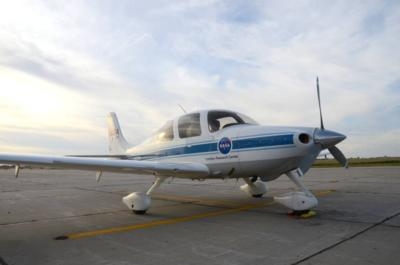Tue, Jul 28, 2015
Both A Hexacopter Drone And A Full-Size Aircraft Were Used In A UAS Experimental Delivery Test
It has already been reported that a Flirtey Inc. hexacopter was used to deliver medical supplies in rural Virginia, but there is more to this story. NASA joined with the FAA in the medical supply drone delivery research program with their own UAS version of a Cirrus SR-22.

During the tests, a NASA Langley fixed-wing Cirrus SR-22 aircraft, a UAS technology testbed that can be flown remotely from the ground, picked up 10 pounds of pharmaceuticals and supplies from an airport in Tazewell County in southwest Virginia. The plane, which always has a safety pilot on board, delivered the medicine to the Lonesome Pine Airport in Wise County.
"This first unmanned aerial delivery gave us the chance to do some critical research and mission exploration with our Cirrus SR-22," said Frank Jones, deputy director of NASA Langley's Research Services Directorate that oversees all Langley aircraft. "We flew the aircraft remotely beyond visual line of sight for the first time from a portable ground station. We had remotely piloted it a number of times at NASA Langley using our permanent ground station, but this allowed us to demonstrate a new capability that we can use to test unmanned mission concepts and aircraft technologies in a remote location."
The supplies went to a Flirtey crew, which separated them into 24 smaller packages so they could be delivered by a small, unmanned, drone during a number of flights over two hours. A company pilot controlled the hexacopter, which lowered the pharmaceuticals to the ground by tether.
The flight also allowed Langley to look at the safety case for use of UAS to deliver supplies to remote areas, including the transfer from aircraft to small drones.
Langley researchers are also part of NASA's UAS Integration in the National Air Space Project, which is working to provide research findings to reduce technical barriers associated with integrating UAS into the NAS using integrated system level tests.
(Image of UAS SR-22 provided by NASA)
More News
Have A Story That NEEDS To Be Featured On Aero-News? Here’s How To Submit A Story To Our Team Some of the greatest new stories ANN has ever covered have been submitted by our>[...]
“The legislation now includes a task force with industry representation ensuring that we have a seat at the table and our voice will be heard as conversations about the futur>[...]
Aero Linx: Waco Museum The WACO Historical Society, in addition to preserving aviation's past, is also dedicated and actively works to nurture aviation's future through its Learnin>[...]
Adcock Range National low-frequency radio navigation system (c.1930-c.1950) replaced by an omnirange (VOR) system. It consisted of four segmented quadrants broadcasting Morse Code >[...]
Also: uAvionix AV-Link, Does Simming Make Better Pilots?, World Games, AMA National Fun Fly Czech sportplane manufacturer Direct Fly has finished delivering its 200th ALTO NG, the >[...]
 ANN FAQ: Submit a News Story!
ANN FAQ: Submit a News Story! Aero-News: Quote of the Day (06.12.24)
Aero-News: Quote of the Day (06.12.24) ANN's Daily Aero-Linx (06.12.24)
ANN's Daily Aero-Linx (06.12.24) ANN's Daily Aero-Term (06.12.24): Adcock Range
ANN's Daily Aero-Term (06.12.24): Adcock Range Airborne Affordable Flyers 06.06.24: 200th ALTO, Rotax SB, Risen 916iSV
Airborne Affordable Flyers 06.06.24: 200th ALTO, Rotax SB, Risen 916iSV



